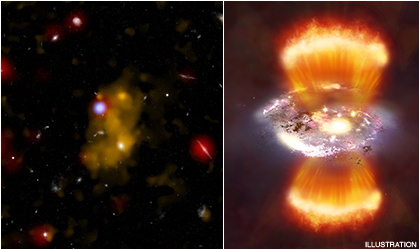For Release: June 24, 2009
CXC

Credit: Left panel: X-ray (NASA/CXC/Durham Univ./D.Alexander et al.); Optical (NASA/ESA/STScI/IoA/S.Chapman et al.); Lyman-alpha Optical (NAOJ/Subaru/Durham Univ./Y.Matsuda et al.); Infrared (NASA/JPL-Caltech/Durham Univ./J.Geach et al.); Right, Illustration: NASA/CXC/M.Weiss
Press Image and Caption
The "coming of age" of galaxies and black holes has been pinpointed, thanks to new data from NASA's Chandra X-ray Observatory and other telescopes. This discovery helps resolve the true nature of gigantic blobs of gas observed around very young galaxies.
About a decade ago, astronomers discovered immense reservoirs of hydrogen gas -- which they named "blobs" - while conducting surveys of young distant galaxies. The blobs are glowing brightly in optical light, but the source of immense energy required to power this glow and the nature of these objects were unclear.
A long observation from Chandra has identified the source of this energy for the first time. The X-ray data show that a significant source of power within these colossal structures is from growing supermassive black holes partially obscured by dense layers of dust and gas. The fireworks of star formation in galaxies are also seen to play an important role, thanks to Spitzer Space Telescope and ground-based observations.
"For ten years the secrets of the blobs had been buried from view, but now we've uncovered their power source," said James Geach of Durham University in the United Kingdom, who led the study. "Now we can settle some important arguments about what role they played in the original construction of galaxies and black holes."
Galaxies are believed to form when gas flows inwards under the pull of gravity and cools by emitting radiation. This process should stop when the gas is heated by radiation and outflows from galaxies and their black holes. Blobs could be a sign of this first stage, or of the second.
Based on the new data and theoretical arguments, Geach and his colleagues show that heating of gas by growing supermassive black holes and bursts of star formation, rather than cooling of gas, most likely powers the blobs. The implication is that blobs represent a stage when the galaxies and black holes are just starting to switch off their rapid growth because of these heating processes. This is a crucial stage of the evolution of galaxies and black holes - known as "feedback" - and one that astronomers have long been trying to understand.
"We're seeing signs that the galaxies and black holes inside these blobs are coming of age and are now pushing back on the infalling gas to prevent further growth," said coauthor Bret Lehmer, also of Durham. "Massive galaxies must go through a stage like this or they would form too many stars and so end up ridiculously large by the present day."
Chandra and a collection of other telescopes including Spitzer have observed 29 blobs in one large field in the sky dubbed "SSA22." These blobs, which are several hundred thousand light years across, are seen when the Universe is only about two billion years old, or roughly 15% of its current age.
In five of these blobs, the Chandra data revealed the telltale signature of growing supermassive black holes - a point-like source with luminous X- ray emission. These giant black holes are thought to reside at the centers of most galaxies today, including our own. Another three of the blobs in this field show possible evidence for such black holes. Based on further observations, including Spitzer data, the research team was able to determine that several of these galaxies are also dominated by remarkable levels of star formation.
The radiation and powerful outflows from these black holes and bursts of star formation are, according to calculations, powerful enough to light up the hydrogen gas in the blobs they inhabit. In the cases where the signatures of these black holes were not detected, the blobs are generally fainter. The authors show that black holes bright enough to power these blobs would be too dim to be detected given the length of the Chandra observations.
Besides explaining the power source of the blobs, these results help explain their future. Under the heating scenario, the gas in the blobs will not cool down to form stars but will add to the hot gas found between galaxies. SSA22 itself could evolve into a massive galaxy cluster.
"In the beginning the blobs would have fed their galaxies, but what we see now are more like leftovers," said Geach. "This means we'll have to look even further back in time to catch galaxies and black holes in the act of forming from blobs."
These results will appear in the July 10 issue of The Astrophysical Journal. NASA's Marshall Space Flight Center in Huntsville, Ala., manages the Chandra program for NASA's Science Mission Directorate in Washington. The Smithsonian Astrophysical Observatory controls Chandra's science and flight operations from Cambridge, Mass.
Media contacts:
Janet Anderson
NASA Marshall Space Flight Center, Ala.
256-544-6162
janet.l.anderson@nasa.gov
Megan Watzke
Chandra X-ray Center, Cambridge, Mass.
617-496-7998
mwatzke@cfa.harvard.edu
http://chandra.harvard.edu/
and
http://chandra.nasa.gov




Visitor Comments (24)
The actual cause of geometrical structure in this is oscillations between two different confocal oblate spheroids.
Posted by Anil Thanvi on Thursday, 06.20.13 @ 20:47pm
I am interested in how these objects are imaged via spectroscopy and telescope. Second in which direction these objects lie? and lastly is there a catalog for these object for the general public to access.
Thanking you in advance.
Posted by graham sing on Monday, 08.20.12 @ 19:33pm
What a fantastic site and for all the illuminating information on galaxy creation and their relationships to black holes. Has Chandra been able to locate galaxies blobs farther than 11.5 billion light years? We're almost witnessing the beginning of the universe anyway at such distances, but how wonderful to see at 13 billion light years.
Posted by Christopher Harper on Tuesday, 10.5.10 @ 19:49pm
I am really enjoying reading your well written articles.
Posted by prozestra on Friday, 07.2.10 @ 04:55am
I am really enjoying reading your well written articles. It looks like you spend a lot of effort and time on your blog.
Posted by prozestra on Friday, 07.2.10 @ 04:55am
Is there a map showing the location of Lyman alpha blobs with respect to the celestial equator?
Thanks
Marvin Glover
Posted by marvin Glover on Wednesday, 11.18.09 @ 14:17pm
Dear Marvin,
Thanks for your question. Lyman-alpha blobs were first discovered about
ten years ago. This paper gives some references to the early work in the
introduction:
http://lanl.arxiv.org/abs/0904.0452
Use this web-site to search for free copies of the various papers.
-P.Edmonds for CXC
Posted by P. Edmonds on Tuesday, 11.10.09 @ 11:23am
Can you tell me when Lyman-Alpha blobs were first discovered and is there any literature about how they were discovered?
Marv
Posted by Marvin Glover on Friday, 11.6.09 @ 17:59pm
I thank you for taking me out of my own, sometimes frustrating, medical research into a new world of wonder and beauty.
Posted by dr. sj robinson on Monday, 10.5.09 @ 08:51am
This paper tells me a lot of things about cosmic.
Thanks very much.
Posted by Hz on Thursday, 08.20.09 @ 23:03pm
chandra.harvard.edu is the best. Keep it going. Have a nice day.
Tania
Posted by Tania on Tuesday, 07.14.09 @ 09:14am
kristianna:
Thanks for your question. Black holes are incredible objects, but the
evidence for a massive black hole in the center of our galaxy is very
strong and based on multiple lines of evidence. There is also very strong
evidence for smaller black holes with masses of about ten times the mass of the Sun. Please explore our field guide for more information about black
holes: http://chandra.harvard.edu/field_guide.html
-P.Edmonds for CXC
Posted by P. Edmonds on Wednesday, 07.8.09 @ 12:14pm
Garth Barber:
Thanks for your compliments on the artist's impression. The redshift is
3.09. At this high redshift there is very limited information about
metallicity and the authors do not make any estimates in this latest
study.
-P.Edmonds for CXC
Posted by P. Edmonds on Wednesday, 07.8.09 @ 12:10pm
Thank you very much for these marvel photos and to all the staff behind this job.
Posted by Fakhri H Ibrahim on Thursday, 07.2.09 @ 05:42am
What is the red shift of this object? What metallicity is observed? A remarkable artists impression on the right, thank you.
Posted by Garth Barber on Thursday, 07.2.09 @ 03:21am
In the atomic structure of matter there is a nucleus that matter centers around in the earliest stages of galactic formation gas is pulled to the center of what. It is hard for me to imagine matter being pulled to the center of nothing. Is there such a thing as a Black Hole or is the center of the galaxy something else like heavy-matter that creates a hub of a wheel that all ordinary matter spins around through its gravitational vortex? I feel that there is a piece of the puzzle that is missing from the equation like what could be so heavy that it could create enough gravity that would pull all matter to itself and be the creator of galaxies and the universe.
Posted by kristianna on Wednesday, 07.1.09 @ 22:01pm
Thank you for the tour of the universe, a truly magnificent journey it continues to be.
Posted by Craig on Wednesday, 07.1.09 @ 21:15pm
The continued search into our roots generates even more questions. The pictorial journey above by Chandra enlightens while simultaneously dazzling us. We are only 2 billion years of the past light away from our earliest conception. However, now I understand how a black hole can develop so quickly after creation of the Universe. KEEP UP THE GREAT WORK.
Posted by Roger Parkhurst on Tuesday, 06.30.09 @ 23:27pm
Very informative. Fantastic pictures.
Posted by don nott on Saturday, 06.27.09 @ 11:48am
Is really amazing how much we approach to the first steps of the formations of galaxies and black holes, some day the science will be capable of to unveil completely to this secrets and will prove finally the important role that play the black holes in the formations of the galaxies and much of this we will have to thanks to the people of Chandra, for the great job they are doing to contribute to many discovery like that.
Posted by Donis Gárciga on Friday, 06.26.09 @ 11:10am
So good to learn about, thanks a lot.
Posted by Angela on Thursday, 06.25.09 @ 14:34pm
Chandra has done fabulous job, providing clues on galaxy formation.
Bravo, keep going on.
Thanks again for the wonderful job, you people are doing.
Posted by dr ghanz patel on Thursday, 06.25.09 @ 13:45pm
Excelent brilliant. thanks a lot.
Posted by Jose Ovidio on Thursday, 06.25.09 @ 12:32pm
Fantastic, Many thanks.
SRS
Posted by Dr S Ranga Sreenivasan on Thursday, 06.25.09 @ 08:45am